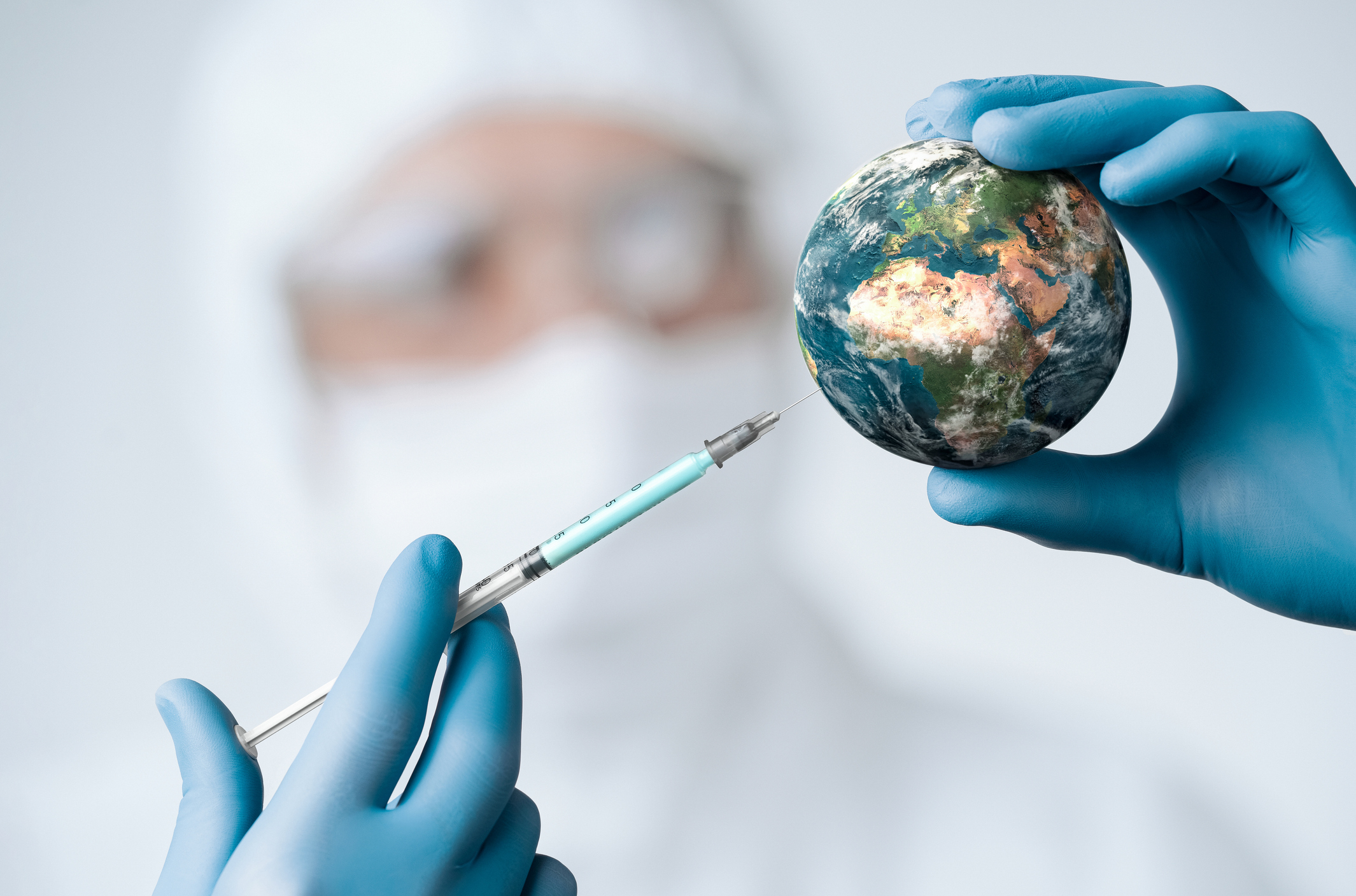Warnings of “corruption and incompetence coming together,” as economists William Lazonick and Öner Tulum study the race to end the pandemic.
Mounting delays, technical glitches, scheduling snafus. Companies, countries, and coalitions jockeying for position. The vaccine rollout we’ve all been waiting for is underway, featuring sky-high stakes and mind-bending complexities that seasoned experts struggle to comprehend.
Economist and business historian William Lazonick has spent a career studying how corporations function and analyzing their interaction with state and society. His critique of the shareholder value regime that swept American business culture in the 1980s — the idea that corporations should be run primarily to enrich stock traders — illuminated widespread misunderstanding of the role large firms play in the economy. His work reveals how dysfunctional business models drive instability and inequality.
Lazonick, critical of the rise of a financialized pharmaceutical industry business model that puts profits ahead of human life, has warned that companies fixated on manipulating stock prices in order to funnel money to shareholders are no longer focused on making the drugs people need at prices they can afford. As he sees it, these firms have morphed from socially useful and innovative enterprises into predatory, scofflaw monopolies that restrict the output of medicines and push prices out of reach.
Now, with the world’s attention riveted on the pandemic, Lazonick and co-researcher Öner Tulum, who has delved into the tension between innovation and financialization in the pharmaceutical industry, turn to real-time analysis of the vaccine rollout. Together, they examine how businesses, governments, and various civil-society coalitions are working together – and competing – to inoculate the planet against Covid-19.
The researchers focus on four key questions related to demand, capacity, scale, and control, each of which reveal the challenges to and pitfalls of an unprecedented mass-production effort that is critical to bringing the pandemic to an end. Now that Covid-19 vaccines are attaining regulatory approval, Lazonick and Tulum are monitoring the constraints posed to mass inoculations by the problems of limited manufacturing capacity, logistics of scaling up production, and competition by companies, countries, and coalitions for control over vaccine supply.
1. How much vaccine do we need?
By the researchers’ reckoning, there are 5.5 billion people in the world 18 years and older who need two shots of a Covid-19 vaccine (at least until a one-shot vaccine is approved), which means that 11 billion doses total would be required to vaccinate all of them.
Together, China and India account for nearly 40% of that 11 billion total. But not everybody needs to get vaccinated in order to beat coronavirus, so it may only be necessary to have 75% of people receiving two shots, in which case, about 8.3 billion doses worldwide would do the job.
Lazonick and Tulum note that the percentage of a population requiring inoculation may vary from country to country, depending on how individual nations have been handling the pandemic. A country like the U.S., for example, which has failed to take all of the recommended countermeasures to keep the virus in check, may need a higher proportion of its people inoculated, and much more quickly, compared to a country like South Korea, which has shown dramatically better control over the virus due to more robust measures taken and more social discipline to coordinate action from the outset of the pandemic and when surges occur.
Whatever the precise number of vaccine doses that will be required to end the pandemic, however, the mega-challenge facing the world is now the limited manufacturing capacity available to supply that demand.
2. How much capacity is out there?
Let’s say the world needs enough capacity to make just over 8 billion doses, plus all the stuff required to use them, ranging from new machinery for Covid-19 vaccine production, chemical ingredients, glass vials, and purified water — never mind the timeframes for constructing new manufacturing facilities. Lazonick and Tulum estimate that if we had three or four years to complete the entire global rollout, we could get all the production processes and supply chains in order and have those doses distributed, no problem.
But we need it faster than that. A lot faster, because the coronavirus is extremely contagious, and potentially becoming more so as the virus mutates. The polio virus, in comparison, was less easily passed from person to person. You couldn’t get it by standing next to somebody infected — you’d need to drink water or eat food contaminated by their stools. Lazonick notes that in the 1950s, there was more time to roll out the polio vaccine and eradicate the virus. Today’s challenge is more akin to the urgency faced by New York City in 1947 when six million people were vaccinated against smallpox in less than a month to nip that contagion in the bud.
With Covid-19, however, we are launching inoculations with a full-blown pandemic continuing to escalate on a global scale.
Lazonick notes that Big Pharma was never all that enthusiastic about vaccines to begin with because, contrary to what anti-vaxxers will often tell you, they just aren’t big money-makers. Although vaccines are given to lots of people, the industry profits far more from therapies and medicines that people have to take every day or every week. Because so many people have to take vaccines, there are also limits to how much can be charged, particularly in developing countries. Then there are significant liability issues inherent in mass inoculations that make pharmaceutical companies nervous.
Tulum observes that the capacity to produce vaccines is controlled by a few Big Pharma firms and about ten large contract manufacturers, which are companies that provide services to drug companies. He adds that there are really only four global companies with sufficient capacity for a pandemic-sized vaccination effort on their own: Pfizer, GlaxoSmithKline, Sanofi Pasteur, and Merck. And the only reason the big guys have this capacity is because governments have incentivized them to build it.
Tulum explains that in the U.S., for example, companies ramped up vaccination production in recent decades because the Clinton administration began to contract with them to vaccinate kids. In China, four companies, all backed by the Chinese government, have vaccine-production capability, while in India, the Serum Institute of India, a family-owned business, is the largest vaccine manufacturer in the world, with a current capability of producing 1.5 billion doses per year.
Contract manufacturers came on the scene because start-up companies designing new drugs lacked the ability to manufacture them. Lazonick explains that since the 1980s, Big Pharma companies have been buying up small biotech companies in order to grow, doing less research and development themselves. “You’ve got about 20 Big Pharma companies, like Pfizer, AstraZeneca, and so on,” says Lazonick, “which do manufacturing and distribution for smaller companies, like Moderna and Germany’s BioNTech, which are designing new drugs but don’t have much manufacturing capacity.”
All of which brings us to an even more daunting challenge: logistics.
3. What could go wrong, logistically?
The rapid scaling up of production for Covid-19 vaccines is a tremendous challenge. Not only must the vaccine be produced, it must be made on a massive scale. Already, reports indicate a wide range of problems and glitches.
Many issues involve the supply chain, in part because every company is competing with other companies all over the world for stuff needed for the manufacturing processes. Already, there are problems with firms getting access to the various types of machines and materials required. Pfizer, for example, slashed production projections for 2020 from 100 million to 50 million doses and then agreed to provide 100 million extra doses to the U.S. for 2021 in exchange for receiving priority from the government in the delivery of resources.
Equipment is an especially tough hurdle. The messenger RNA vaccine that Pfizer/BioNTech and Moderna have developed, for example, requires new types of machinery that have never previously been used for mass production. In the case of the Moderna vaccine, now approved for emergency use, the U.S government has been lining up contract manufacturers, one of which, Swiss-based Lonza, is doubling its manufacturing capacity at a facility in New Hampshire.
So far, just over 2 million people in the U.S. have gotten their initial dose – that’s nearly 18 million short of the number promised by the federal government by the end of the year. Recent reports indicate that states have been cut back on the number of Pfizer doses they were promised as much as 30-40%. Pfizer, in its defense, claimed to have vaccine sitting on its warehouse shelves that President Trump’s Operation Warp Speed was supposed to take control of and deliver. U.S. Army Gen. Gustave Perna, who oversees logistics, said the confusion was caused by a “planning error” in which the initial vaccine numbers he provided to states were higher than the number of doses actually available for release.
But is that really the whole story?
Lazonick and Tulum are looking into questions raised by investigative journalist Olivia Goldhill, who thinks that the snafu may be related to sensors required to monitor the temperature of the Pfizer vaccine, which requires a storage temperature of minus 94 degrees Fahrenheit. If the vaccine becomes too warm or even too cold, it gets ruined (already, 3,000 doses of Pfizer’s vaccine on the way to California and Alabama had to be quarantined and shipped back to the company after the vials got too cold).
According to Goldhill, Pfizer has the sensors necessary to monitor the temperature while the vaccine is being stored in its own warehouses, prior to shipment. But the federal government had not invested adequately in the devices before assuming quality control after the handoff from Pfizer. Instead, it has simply left the vaccine supply in Pfizer’s hands while telling various states that they will receive far fewer doses now than had been promised.
Bottom line: a lot can go wrong, and things may be more complicated and chaotic than many realize. The vaccine rollout is rife with potential bottlenecks, supply challenges, possibilities for contamination, and other issues that could reduce the number of available doses.
Last, we come to perhaps the most pressing question of all. Who is in control of the vaccine supply?
4. Who controls the vaccine rollout?
A variety of companies, countries, and coalitions are vying to control access to limited manufacturing capacity and vaccine doses that can be produced now and as the rollout continues over the next years or so.
This is where geopolitics comes in: Who gets the vaccine first? In what order? How fast? Who makes the calls?
The U.S. and the U.K. are the most aggressive countries when it comes to seeking control over manufacturing capacity, supply chains, and vaccine output. For its part, the European Union (EU) is acting as a bloc to procure for member countries. At the same time, various coalitions have entered the competition, the most prominent of which is COVAX, an initiative coordinated by GAVI, the Coalition for Epidemic Preparedness Innovations (CEPI), and World Health Organization (WHO).
Lazonick and Tulum point out that according to one report on vaccine manufacturing capacity prior to the pandemic, 76% of the capacity was located in Europe; 13% in North America; and 8% in Asia. Nevertheless, because manufacturing capacity is under the direct control of companies, not countries, the EU has been less successful than the U.S. and U.K. in gaining procurement commitments. The upshot is that the German media has been lambasting the EU procurement plan as “too little, too late.” Much depends on which vaccines under development get regulatory approval; the EU has a big stake in one being developed by Sanofi Pasteur, but its clinical trial process is taking longer than expected and success is by no means assured.
Brexit means that the U.K. is not a member of the EU bloc, leaving it free to negotiate on its own. The U.K. was the first to approve the BioNTech/Pfizer vaccine, and before Christmas, over half a million people in the country had received vaccinations. The U.K. is also home to a leading vaccine candidate being developed by a team at Oxford University, which made a smart move by granting manufacturing and marketing rights to AstraZeneca, the Anglo-Swedish company that is among the Big Pharma global leaders. Still, that doesn’t mean that the U.K. will have privileged access to AstraZeneca’s output.
The U.S. has been the most aggressive of all in the procurement competition, with its Operation Warp Speed run out of the Department of Health and Human Services (HHS) in collaboration with the Department of Defense. There’s been a lot of wheeling and dealing, and mind-blowing amounts of money poured into companies for bringing vaccines online extremely quickly.
A few highlights:
- As early as May 2020, Operation Warp Speed paid AstraZeneca $1.2 billion to make at least 300 million vaccine doses for the U.S., if and when its Oxford candidate, already approved in many countries, gets the green light in the United States.
- Operation Warp Speed also has a close relation with Moderna, the American company that has just had its mRNA vaccine approved in the U.S. Beyond the generous funding Moderna has enjoyed over the years from the National Institutes of Health for drug development, it received a base award of $430 million for development of its Covid-19 vaccine in April 2020.
- In May, the HHS’ Biomedical Advanced Research and Development Authority (BARDA) paid $53 million to support the expansion of Lonza’s manufacturing facility for the Moderna vaccines in New Hampshire. Later, in July, Operation Warp Speed (which includes BARDA and the National Institute of Allergy and Infectious Diseases) awarded Moderna $472 million for its Phase 3 clinical trials. Then in August, the program struck a procurement contract with Moderna for 100 million doses for $1.5 billion, with an option to purchase another 400 million doses manufactured in the U.S. by Lonza.
- Pfizer refused to take development funds from Operation Warp Speed for the BioNTech vaccine, restricting its relationship with the program to an initial procurement contract for 100 million doses for $1.95 billion and the option to purchase another 500 million. As mentioned above, when the U.S. government wanted to contract for an additional 100 million doses in December, Pfizer was able to bargain to ensure privileged access to supply-chain requirements as a condition for the deal.
This is Trump’s vision of “putting America first.”
Lazonick notes that the U.S. infrastructure for healthcare delivery was underfunded even before Trump occupied the White House, with matters worsened by the incompetence and negligence of his administration in preparing for and responding to the pandemic. This is why the vaccine rollout faces problems in the U.S. even when vaccines are made available from the manufacturers. As he puts it, “Operation Warp Speed has been very active in paying billions of taxpayer money for procurement contracts and thus hoarding access to the very limited supply of vaccines that the whole world needs, but very inactive in making sure that the vaccines on which it puts its hands actually find their way into the arms of the American people.”
Lazonick also warns that the lion’s share of the available Covid-19 vaccines in 2021 will end up going to the rich nations. COVAX is working against that outcome, trying to secure two billion doses by the end of 2021 to protect the highest-risk and most vulnerable people along with front-line health care workers in member countries around the globe.
Not surprisingly, the U.S., which pulled out of WHO, is not a COVAX member. But for 92 poorer nations, COVAX represents the only coordinated initiative to secure vaccines. Even then, the Duke Global Health Innovation Center in Durham, North Carolina, estimates that many people in low-income countries might have to wait until 2023 or 2024 for their coronavirus shots.
As Lazonick sees it, the incoming Biden administration will have a major challenge to consider needs of the global community as it seeks to vanquish the out-of-control pandemic at home. Will the U.S. be a supporter or an obstructor of the worldwide vaccination effort? Stay tuned.






